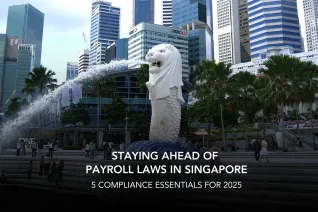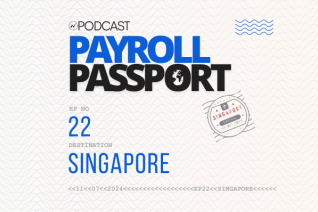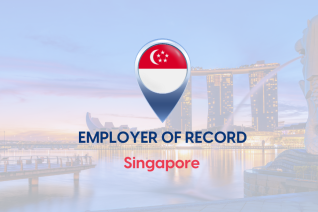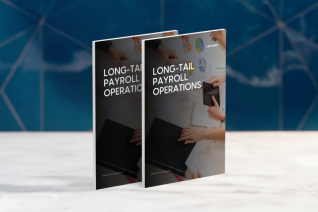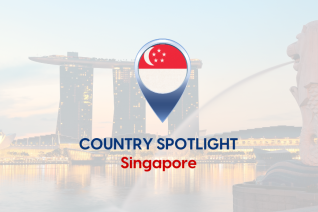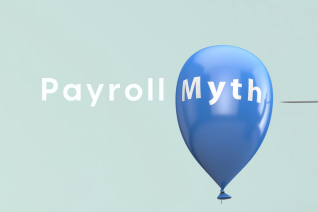Establish your presence globally with Neeyamo as we help you go beyond borders to manage your international payroll and hire new talent in Singapore.
Overview
Singapore is a sovereign city-state located in Southeast Asia. It is situated at the southern tip of the Malay Peninsula, with maritime borders with Malaysia to the north and Indonesia to the south. Despite its small size, Singapore has a highly developed and diverse economy.
Singapore is a global financial hub and a major center for trade and commerce. It has a highly skilled workforce and a business-friendly environment that attracts multinational corporations and entrepreneurs worldwide. The country strongly focuses on innovation, technology, and research and development.
Some key industries in Singapore include finance and banking, manufacturing, logistics and transportation, electronics, pharmaceuticals, biotechnology, information technology, and tourism. The country is also a major hub for oil refining and petrochemicals.
Neeyamo assists with onboarding and managing employees in Singapore and processing a firm's payroll, compliance, benefits, and more.
Our Presence
Tools And Instances
Facts And Stats
Capital
Singapore
Currency
Singapore Dollar (SGD)
Official Language
Malay
Fiscal Year
01 April - 31 March
Date Format
DD/MM/YYYY
Country Calling Code
+65
Other Languages
English, Mandarin, Tamil
Time Zone
UTC + 08:00
Global Payroll
Overview
Handling payroll for a widespread workforce can pose a significant challenge for any organization, and the added complication of compliance can make things worse. If companies spend more time processing payroll, it directly impacts day-to-day operations and their overall productivity.
Over the years, Neeyamo has observed these complexities and strived to provide a global payroll solution through a single technology platform - Neeyamo Payroll. Cloud based payroll service providers, like Neeyamo, assess payroll industry trends and offer a consolidated solution in its Global Payroll Technology Stack making outsourcing payroll cost per employee easier.
Payroll Taxes
Payroll tax is the percentage amount retained from an employee's salary and paid to the government to invest in the general population's welfare. These are statutory in nature and are levied from both the employer and employee. Additional statutory contributions are made by employers towards aiding both short-term and long-term benefits for their employees. Neeyamo aids you in completing all your payroll and tax accounting needs.
Employee Taxes
Employee taxes in Singapore are as follows:
- Central Provident Fund (CPF), 2025:
Age 55 to 60 - Increased from 17% to 18%.
Ages 60 to 65 - Increased from 11.5% to 12.5%. - Singapore personal tax rates start at 0% and are capped at 22% (above S$320,000) for residents and a flat rate of 15% to 22% for non-residents.
Employer Taxes
The CPF is Singapore's national pension scheme. Contributions are payable by Singapore citizens and Singapore Permanent Residents (i.e., SPR obtained via immigration rules) only. Employers and employees contribute 17% and 20% of ordinary monthly wages, up to an income ceiling of SGD 6,000. Therefore, their respective maximum contributions are SGD 1,020 and SGD 1,200 per month. The rates apply to Singaporeans and SPRs (from the third year onwards) aged 55 years and below.
An employee will be taxed on all incomes earned in Singapore and subject to the deduction of tax reliefs, the personal income tax rate is progressive, and the highest marginal tax rate is 22%. Social Security in Singapore The Central Provident Fund (CPF) is a comprehensive savings plan that has provided many working Singaporeans with a sense of security and confidence for their retirement years. The employer must pay the employer's and employee's share of CPF contributions every month if they earn more than $50/month. CPF contributions should be determined based on the employee's total wages for a calendar month. When wages are not paid according to the calendar month, employers must allocate the wages according to the calendar month.
Contribution from employer:
- Central Provident Fund (CPF) (2025)
Ages 55 to 60 - Increased from 15.5% to 16%.
Ages 60 to 65 - Increased from 12% to 12.5%. - Skill Development Levy (SDL)- up to 0.25%
- Total employment Payroll contribution costs from 17.00% to 17.25%
* Medical reimbursements are excluded from taxable wages for the Skills Development Levy in Singapore.
Payroll Cycle
Overview
Undoubtedly, payroll is a critical process for any organization. Pay cycle in Singapore refers to the period for which an organization pays its employees, and this can vary depending on the pay frequency that the organization chooses to adopt.
Frequency
The frequency cycle is monthly. It is paid within seven days of the end of the salary period. In the event of termination/resignation, payment is due on the last day of work.
13th Month Cycle
A 13th-month bonus or annual wage supplement is not legally mandated in Singapore. The 13th-month pay, also known as the Annual Wage Supplement (AWS), is a standard business practice used by companies in Singapore.
Global Work
Overview
An Employer of Record services (EOR) provider helps you eliminate the hassle of handling complexities while onboarding a new employee in an international location. They help bridge the gap that otherwise mandates organizations to have a local registered entity and a local bank account, prior to making a job offer to an international hire.
An Employer of Record services provider acts as a legal employer, facilitates salary payments, and manages other statutory requirements such as health insurance, payroll taxes, and employee benefits ensuring compliance with local tax laws and regulations.
This allows organizations to focus on collaborating with the employee in Singapore for operational tasks, with the knowledge that they have a cost-effective solution support their global HR and payroll requirements, as they continue their global expansion.
HR Mandates and Practices
Minimum Wage
Singapore has no minimum wage laws or regulations. There is no mandatory minimum rate of pay for workers in Singapore. Pay rates must be agreed upon directly with the employer through collective bargaining or other means of negotiating a fair living wage.
Average Wages in Singapore increased to 7021 SGD/Month (5235.645 USD/Month) in the first quarter of 2023. The maximum rate of average wage for employees was 6159 SGD/Month and minimum was 1302 SGD/Month.
Overtime
Overtime is all work more than regular working hours, excluding breaks. Employees are allowed to work up to 12 hours per day. An employee can only work up to 72 overtime hours in a month. The overtime rate for non-workmen is capped at the salary level of $2,600 or an hourly rate of $13.60.
Over time work, your employer must pay you at least 1.5 times the hourly basic rate of pay. Payment must be made within 14 days after the last day of the salary period.
Overtime on a rest day or public holiday amounts to 1.5 times the hours worked overtime.
Data Retention Policy
All employers must maintain detailed records of employees covered under the Employment Act. At a minimum, the following employee records must be kept on file:
- The employee's address;
- the employee's National Registration Identity Card number or, for noncitizens, the employment pass number and its expiration date;
- the employee's date of birth;
- the employee's gender;
- The date employment commenced;
- the date employment terminated;
- the employee's working hours, including meal times and breaks;
- dates of public holidays taken and
- Dates of leave.
The employer must keep all employment records for the most recent two years for current employees. For former employees, records must be kept for at least one year after the employee leaves employment.
Hiring and Onboarding Requirements
Hiring
The Tripartite Guidelines on Fair Employment Practices (TGFEP) prohibits discriminatory practices in all Singapore-based organizations. Tripartite partners publish the TGFEP: the Ministry of Manpower (MOM), the National Trades Union Congress, and the Singapore National Employers Federation.
All employers are expected to abide by the TGFEP. According to the TGFEP, employers must recruit and select employees based on merit (e.g., skills, experience, or ability to perform the job), regardless of age, race, gender, religion, marital status, family responsibilities, or disability.
The Fair Consideration Framework (FCF) published by the MOM sets out requirements for all Singapore employers to consider the Singapore workforce fairly for job opportunities. Employers submitting Employment Pass and S Pass applications must first advertise on MyCareersFuture and fairly consider all candidates.
All employers must practice fair hiring even if their job vacancies can be exempted from advertising.
Employers should be careful not to have an exceptionally high share of foreign professionals, managers, executives, and technicians or a very high concentration of a single nationality, as these indicate possible discriminatory hiring practices. Additionally, employers should know that the MOM’s current policy focuses on building a ‘Singapore Core’ in Singapore employers. Accordingly, the MOM is increasingly examining the hiring and employment ratios of foreign professionals and Singapore citizens and residents.
Onboarding
Paperwork and documents are collected which are required for various processes in the company such as registration, benefits to be given, and HR purposes.
Every company has a different policy with their onboarding purpose; usually, it’s a brief about the company and answering questions from the newly hired employee
Probation
The probation period in Singapore is set within the employment contract/collective agreement. Generally, the probation period usually takes three to six months in length.
Leave
Public Holidays
Below is the list of Public Holidays in Singapore for the financial year 2025-26:
| Holiday Name | Date | Day |
|---|---|---|
| New Year’s Day | 1 January 2026 | Thursday |
| Chinese New Year | 17 February 2026 | Tuesday |
| Chinese New Year | 18 February 2026 | Wednesday |
| Hari Raya Puasa | 21 March 2026 | Saturday |
| Good Friday | 3 April 2026 | Friday |
| Labour Day | 1 May 2026 | Friday |
| Hari Raya Haji | 27 May 2026 | Wednesday |
| Vesak Day | 31 May 2026 | Sunday |
| National Day | 9 August 2026 | Sunday |
| Deepavali | 8 November 2026 | Sunday |
| Christmas Day | 25 December 2026 | Friday |
Public Holiday Schedule for 2026: Sunday Substitutions
In line with the Ministry of Manpower (MOM) guidelines, when a public holiday falls on a Sunday, the following Monday will be designated as a public holiday.
Therefore, please note the following adjusted public holidays for 2026:
- Monday, June 1, 2026: (in observance of Vesak Day, which falls on Sunday)
- Monday, August 10, 2026: (in observance of National Day, which falls on Sunday)
- Monday, November 9, 2026: (in observance of Deepavali, which falls on Sunday)
Annual Leave
An employee who has worked for an employer for at least three months is entitled to seven days of paid annual leave from the employer after one full year of service (prorated for a part year). Payment for annual leave is calculated at the employee's gross rate of pay. An employee who has served an employer for not less than three months is, in addition to the rest days, holidays, and sick leave, entitled to:
- Seven days of paid annual leave for the first 12 months of continuous service with the same employer;
- An additional one day of paid annual leave for every subsequent 12 months of continuous service with the same employer;
- A maximum of 14 days of paid annual leave.
An employee who has served an employer for at least three months but has not completed 12 months of continuous service in any year, is entitled to annual leave in proportion to the number of completed months of service in that year.
In calculating the yearly proportionate leave any fraction of a day that is less than one-half of a day must be disregarded, and where a fraction of a day is one-half or more, it must be regarded as one day. Where an employee is granted a leave of absence without pay by an employer at the employee's request, the leave period is to be disregarded to compute the period of continuous service.
An employee forfeits the employee's entitlement to annual leave if the employee absents himself from work without the permission of the employer, or reasonable excuse, for more than 20% of the working days in the months or year (as the case may be) in which the employee's entitlement to annual leave accrues. The employer must grant, and the employee must take, the employee's paid annual leave by 12 months after the end of every 12 months of continuous service. If the employee fails to take that leave by the end of that period, the employee ceases to be entitled to that leave. An employer must pay an employee the employee's gross rate for every day of paid annual leave if an employee is dismissed on any grounds other than misconduct before the employee has taken all the paid annual leave. In that case, the employer must pay the employee the employee's gross pay rate for every day of that leave not taken by the employee.
Sick Leave
Employees with at least six months’ service are entitled to paid sick leave up to 14 days per year if no hospitalization is required. If hospitalization is required, sick leave is limited to the lesser of 60 days or 14 days plus the number of days the employee was hospitalized.
An employee with at least three months’ service but less than six months is entitled to sick leave for up to 5 days if no hospitalization is required. If hospitalization is required, sick leave is limited to the lesser of 15 days each year or the aggregate of 5 days plus the number of days he is hospitalized.
Employees with at least four months of service but less than five months are entitled to paid sick leave of up to 8 days if not hospitalized. If hospitalization is required, the lesser of 30 days in each year or the aggregate of 8 days plus the number of days he is hospitalized.
Employees with at least five but less than six months of service are entitled to 11 days of paid sick leave if no hospitalization is required. If hospitalization is needed, the lesser of 45 days in each year or the aggregate of 11 days plus the number of days he is hospitalized.
An employee whose sick leave has not been certified by a medical practitioner or who has failed to notify the employer within 48 hours of beginning sick leave is deemed to be away from work without permission and a reasonable excuse.
Maternity Leave
Female employees are entitled to 16 weeks of paid maternity leave if they have worked for their employer for at least three months and the child is—or will be—a Singapore citizen. The employer pays the first eight weeks of leave; the government pays the remaining eight weeks. The paid benefit is capped at S$10,000 per month.
A woman qualifies for only 12 weeks' leave if she has worked for her employer for less than three months or her child is not a Singaporean citizen. She will receive eight weeks' pay from her employer if she has fewer than two living children at the time of delivery. The remaining four weeks are unpaid.
If a mother seeks to use maternity leave and the father, with the mother's agreement, aims to use shared parental leave for the same child, the mother's total number of available weeks of maternity leave would be reduced by the number of shared paternal leave taken by the father.
Leave payment is halved if at least one week's notice of intent to take maternity leave is not given. An employer may not require an employee to work during the first four weeks after childbirth. With the employer's consent, the final eight weeks of maternity leave may be taken flexibly at any time before the child's first birthday. Employees cannot be dismissed while they are on maternity leave.
Paternity Leave
Working fathers who have been continuously employed for at least three months are entitled to two weeks of government-paid paternity leave if:
- They are married to the child’s mother, and
- The child is a citizen of Singapore or will become a citizen of Singapore by the time they are one year old.
The two weeks of leave can be taken in a continuous block within 16 weeks of the child’s birth or 12 months from the delivery (subject to an agreement with the employer). Working fathers are also entitled to share four weeks of their wife’s 16 weeks of government-paid maternity leave.
Adoption Leave
Adoptive mothers of children under 12 months old are entitled to 12 weeks of paid leave. To qualify, the woman must have worked for her employer at least three months immediately before the adoption, and the child must be a Singapore citizen.
If the child is a foreigner, one of the adoptive parents must be a Singaporean citizen, and the child must become a Singaporean citizen within six months of adoption. Adoption leave must be concluded before the child’s first birthday. The employer pays the first four weeks of the leave period; the government pays the remaining eight weeks.
Adoptive fathers of children under 12 months old are entitled to two weeks of paid leave. To qualify, the father must have worked for his employer at least three months immediately before the adoption, and the child must be a Singaporean citizen. If the child is a foreigner, one of the adoptive parents must be a Singaporean citizen, and the child must become a Singaporean citizen within six months of adoption.
Unpaid Infant care Leave
Working parents who have been employed continuously for at least three months and have a child under two years of age are entitled to 6 days of unpaid infant care leave a year if the child is a Singapore citizen. Employee shall not be entitled to more than 12 days of unpaid infant care leave for any qualifying child. The unpaid infant care leave shall be in addition to the rest days, holidays, annual leave, and sick leave to which an employee is entitled.
Military Leave
An employer must grant a leave of absence for the duration of an enlistment period and must reinstate an employee who has been in continuous employment for at least six months before the date on which the employee was to report for active national service for the Singapore Armed Forces, including the Police Force.
Government-paid Childcare Leave
Employees who are parents with Singaporean children below the age of 7 are entitled to 6 days of Government-Paid Childcare Leave (GPCL) per parent per year. Any unused leave from one year cannot be carried forward to the next annual year.
The total number of GPCLs that a parent may receive is capped at 42 days (6 days a year x 7 years)
Extended Childcare Leave
Eligible working parents who have any Singapore citizen child between 7 and 12 years old (both inclusive) can enjoy two days of leave per relevant period.
Your child is a Singapore citizen (or obtains Singapore citizenship at any time during the relevant period) and is between 7 and 12 years old (both inclusive) at any time during the applicable period.
For employees: You have served your employer for a continuous period of at least three months.
Shared Parental Leave
Shared Parental Leave (SPL) enables working dads to share up to 4 weeks of their wife’s 16 weeks of Government-Paid Maternity Leave, subject to agreement by their wives. There isn’t a fixed arrangement on how working father should take their L, so companies are encouraged to work out a mutual agreement with their employees.
National Service Leave
Under section 23 in the Enlistment Act, it is stated that employers are obligated to grant their employees a paid leave of absence when they are called to perform NS duties.
In the case of full-time National Service, section 21 of the Enlistment Act further states that employers must arrange for employees to return to work as soon as they complete training if they have worked with the company for at least six months.
Unpaid/ Other Leave
In Singapore, many companies offer extended service, Study, marriage, and Bereavement leave. The government does not mandate these leaves. It depends upon company policies.
Termination
Notice Period
The party to an employment contract may notify the other party of the intent to terminate the agreement. Notice of termination must be in writing.
Unless the notice period is specifically outlined in the contract, the following notice must be given:
- one day's notice if the period of employment is less than 26 weeks,
- one week's notice if the period of employment is at least 26 weeks but less than two years,
- two weeks' notice if the period of employment is at least two years but less than five years and
- four weeks' notice if the period of employment is five years or more.
Either party may choose to waive the right to receive notice.
In place of providing the requisite notice, the terminating party may pay the other party an amount equal to the wages the employee would have earned during the notice period.
Severance Pay
In Singapore, employment contracts/collective agreements contain "retrenchment benefit" payments due upon termination once an employee has completed two years of service. It is common practice for this to be 2–4 weeks' pay for each year of employment.
Visa
Overview
Foreign nationals may be employed in Singapore only if they have obtained a work pass from the Controller of Work Passes. Employers pay a monthly assessment for each foreign employee and must keep a record of all persons for whom a work pass has been issued.
A foreign worker must not be in Singapore at the time of the work permit application. There are different types of work permits for various types of work. The duration of the work permit is usually two years.
Types of visas
The most common types of work permits are as follows:
- Employment Pass (EP): This visa is issued to foreign professionals, managing directors, general managers, CEOs, executives, and specialists that meet a minimum salary threshold.
- S Pass: Mid-level skilled foreigners (e.g., technicians) that meet a minimum salary threshold can apply for an S Pass. A quota limits the number of S Pass holders employers can hire. Employers must also pay a monthly levy for these workers.
- Entrepreneur Pass (EntrePass): This one-year visa allows eligible foreign entrepreneurs to start and operate a business in Singapore.
- Personalized Employment Pass (PEP): Individuals applying for this three-year visa must be overseas foreign professionals meeting the minimum salary threshold as required by law. PEP holders can generally take on employment in any sector and do not have to reapply for a visa when changing jobs.
- Miscellaneous Work Pass: This visa, valid for up to 60 days, is for eligible foreigners working on short-term assignments.
Application process
The Ministry of Manpower has developed an online web portal to enable employers to apply for work permits via the internet.
Effective Sept. 1, 2023, Singapore will introduce a new points-based Complimentary Assessment Framework (COMPASS). New Employment Pass (EP) applicants will be required to score at least 40 points under the framework, considering factors such as salary, qualifications, diversity, and support for local government. EP renewal applications take effect on Sept. 1, 2024. Applicants will be exempt from COMPASS if their salary exceeds a maximum threshold or they are filling short-term roles.
Overseas Networks and Expertise (ONE) Pass. Effective Jan. 1, 2023, this five-year visa will be available to individuals who earn at least S$30,000 per month or can demonstrate that they play a leading role in an established company. The visa allows workers’ dependents to seek employment.
Employee Background Checks
Legal and Background Checks
There are no express restrictions on prohibitions against background checks, but the Personal Data Protection Act (PDPA) provides for limited restrictions. It may limit the personal information available to perform the background check. Further, the PDPA only allows an employer to collect, use and disclose personal data without the employee's consent if the personal data collection, use, or disclosure is reasonable for or in retention to the employer entering an employment relationship with the employee. An employer should not collect personal data for background checks if it is not with the employment relationship.
This is the same if an employer hires a third party to conduct the checks. The employer should ensure that the third party only collects information concerning the employment relationship.
Medical Test
There are no restrictions or prohibitions against requiring a medical examination as a condition of employment. An employer can collect such data if it is in relation to entering into an employment relationship.
However, if the employer is discriminatory in its hiring practices, such as not hiring an employee due to a disability discovered in a medical examination, this could potentially breach the Tripartite Guidelines on Fair Employment Practices (TGFEP) and expose the employer to potential sanctions.
Drug and alcohol Test
There are no restrictions or prohibitions against drug and alcohol testing of applicants. An employer can collect such data if it is in relation to entering into an employment relationship.
However, if the employer is discriminatory in its hiring practices, this could breach the TGFEP and expose the employer to potential sanctions.
The requirement to Verify Educational Qualifications for all EP Applications
MOM is expanding its requirement for employers to verify educational qualifications submitted to MOM to support EP applications to ensure authenticity and quality.
MOM will require employers to verify candidates' diploma-level and above qualifications through background screening companies, online portals, and digital certificates.
Last updated on June 20, 2025.
If you have any queries or suggestions, reach out to us at irene.jones@neeyamo.com
Have Queries? Get In Touch With Us
Get in touch with one of our experts and take a quick demo of our services





